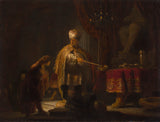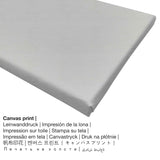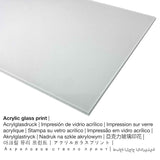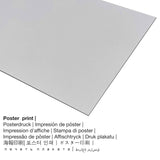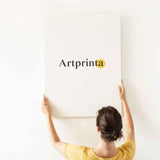Rembrants van Rijns, 1633. gads - Daniels un Sairuss pirms elka Bel - tēlotājmākslas apdruka
PVN iekļauts. Piegāde aprēķināta Pie izrakstīšanās
Muzeja informācija par mākslas darbu (© - Dž. Pola Getija muzeja - J. Paula Getija muzejs)
When King Cyrus of Persia, seen at the center, asked his confidant Daniel why he does not worship the deity Bel, whose lower half can be seen in the shadows, Daniel replied that he worshipped a living god, not an idol. The king insisted that Bel was a living god and pointed to the offerings of food and wine that Bel consumed every night. Cautiously, Daniel noted that bronze statues do not eat. Cyrus was momentarily bewildered, but the worried faces of the priests in the background confirm that Daniel has exposed their deception. This story of Daniel's dramatic exposure of the king's idol-worship derives from the apocryphal portion of the Book of Daniel. Light illuminates the figures of Cyrus and Daniel, highlighting their dramatic encounter. Rembrandt contrasted the king's grandeur with Daniel's humility. Facing out and gesturing toward the table, the lavishly attired Cyrus appears large and imposing. By contrast, the youthful Daniel seems small, and his posture suggests modesty or submissiveness before his ruler. Rembrandt evoked the exotic mystery of a pagan cult by showing only part of the monumental idol emerging from the flickering lamplight on the right. Inside the shadowy temple, light catches and reflects off the extravagant finery worn by Cyrus and the gold vessels placed atop the velvet tablecloth.
Interesanti fakti par nosaukto mākslas darbu "Daniel and Cyrus Before the Idol Bel"
Gadā 1633 vīrietis holandiešu mākslinieks Rembrandt van Rijn izgatavoja šo mākslas darbu "Daniel and Cyrus Before the Idol Bel". The painting was painted with the dimensions of 23,5 × 30,2 cm (9 1/4 × 11 7/8 in). Eļļa uz paneļa was used by the artist as the medium of the masterpiece. This artpiece can be viewed in in the digital collection of J. Paula Getija muzejs located in Los Angeles, California, United States of America. With courtesy of: The J. Paul Getty Museum (public domain license).Creditline of the artwork: . The alignment of the digital reproduction is ainava ar sānu attiecību 4: 3, Kas nozīmē, ka garums ir par 33% garāks nekā platums. The painter Rembrandt van Rijn was an artist from the Netherlands, whose style was mainly Baroque. The Baroque painter was born in the year 1606 Leidenē un mūžībā aizgāja gadu vecumā 63 gadā 1669.
Izvēlieties savu iecienītāko produkta materiālu
Katram produktam mēs piedāvājam dažādu materiālu un izmēru klāstu. Tāpēc mēs ļaujam jums izvēlēties kādu no šīm iespējām:
- Iespiests akrila stikls (ar īstu stikla pārklājumu): An print on acrylic glass, often referenced as a plexiglass print, will transform the original work of art into beautiful wall décor.
- Audekls: A canvas print, which should not be mistaken with a canvas painting, is a digital replica printed onto cotton canvas fabric. Furthermore, a printed canvas generates a charming and enjoyable atmosphere. How do I hang a canvas on my wall? A canvas print has the advantage of being low in weight. This means, it is easy to hang the Canvas print without the support of extra wall-mounts. Canvas prints are suited for all kinds of walls.
- Plakāts (audekla materiāls): Our poster print is a printed sheet of cotton canvas paper with a nice structure on the surface. Please note, that depending on the size of the canvas poster print we add a white margin of approximately 2-6cm around the artwork, which facilitates the framing.
- Alumīnija dibondraksts: Aluminium Dibond prints are metal prints with an outstanding effect of depth. The Direct Print on Aluminum Dibond is the best start to the sophisticated world of fine art prints manufactured with aluminum. The bright sections of the original work of art shine with a silky gloss but without the glow. The direct print on aluminium is one of the most demanded entry-level products and is an extremely contemporary way to display art prints, since it draws attention on the artwork.
Mākslinieka informācijas tabula
| Mākslinieka vārds: | Rembrandt van Rijn |
| Mākslinieka dzimums: | vīrietis |
| Pilsonība: | holandiešu |
| Profesijas: | gleznotājs |
| Izcelsmes valsts: | Nīderlande |
| Mākslinieka kategorija: | vecmeistars |
| Mākslinieka stili: | Baroka |
| Mūžs: | 63 gadiem |
| Dzimšanas gads: | 1606 |
| Dzimtā vieta: | Leiden |
| Miris gadā: | 1669 |
| Nāves vieta: | Amsterdama |
Mākslinieka detaļas
| Mākslas darbs: | "Daniel and Cyrus Before the Idol Bel" |
| Mākslas darbu klasifikācija: | glezna |
| Vispārējs termins: | klasiskā māksla |
| Mākslas darbu gadsimts: | 17th gadsimts |
| Izveidots gadā: | 1633 |
| Mākslas darba vecums: | 380 gadiem |
| Oriģināls mākslas darba nesējs: | eļļa uz paneļa |
| Mākslas darba oriģinālie izmēri: | 23,5 × 30,2 cm (9 1/4 × 11 7/8 collas) |
| Izstādīts: | J. Paula Getija muzejs |
| Muzeja vieta: | Losandželosa, Kalifornija, Amerikas Savienotās Valstis |
| Muzeja vietne: | J. Paula Getija muzejs |
| Mākslas darba licences tips: | publiski |
| Pieklājīgi no: | J. Paula Getija muzejs |
Strukturēta produkta informācija
| Drukas kategorija: | sienas māksla |
| Pavairošana: | digitālā reproducēšana |
| Ražošanas process: | UV tiešā druka |
| Produkta izcelsme: | izgatavots Vācijā |
| Krājuma veids: | pēc pieprasījuma |
| Paredzētais lietojums: | sienu dekorēšana, mākslas kolekcija (reprodukcijas) |
| Attēla izlīdzināšana: | ainavas formāts |
| Sānu attiecība: | garums, platums - 4: 3 |
| Attēla malu attiecības interpretācija: | garums ir par 33% garāks nekā platums |
| Pieejamie izstrādājumu audumi: | akrila stikla apdruka (ar īsta stikla pārklājumu), audekla apdruka, metāla apdruka (alumīnija dibons), plakāta druka (audekla papīrs) |
| Audekls uz nestuvju rāmja (audekla druka) iespējas: | 40x30cm - 16x12 ", 80x60cm - 31x24", 120x90cm - 47x35 ", 160x120cm - 63x47" |
| Akrila stikla apdrukas (ar īstu stikla pārklājumu) izmēri: | 40x30cm - 16x12 ", 80x60cm - 31x24", 120x90cm - 47x35 ", 160x120cm - 63x47" |
| Plakātu drukas (audekla papīrs) izmēru varianti: | 40x30cm - 16x12 ", 80x60cm - 31x24", 120x90cm - 47x35 " |
| Alumīnija apdruka: | 40x30cm - 16x12 ", 80x60cm - 31x24", 120x90cm - 47x35 " |
| Attēla rāmis: | nav iekļauts |
Svarīga informācija: We try in order to describe the products in as much detail as possible and to exhibit them visually. Still, the tone of the printing material, as well as the print result may diverge marginally from the representation on the device's screen. Depending on your screen settings and the nature of the surface, not all colors are printed as realisitcally as the digital version. Because all art reproductions are processed and printed by hand, there might also be minor deviations in the motif's exact position and the size.
© Autortiesības - Artprinta (www.artprinta.com)

